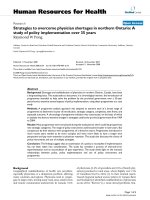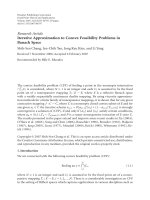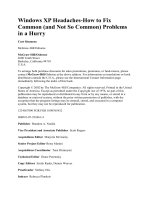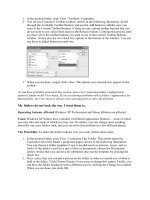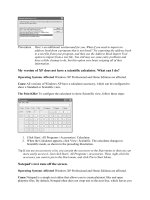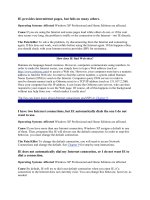Suggestions to overcome the problems in availing the benefits under national horticulture mission
Bạn đang xem bản rút gọn của tài liệu. Xem và tải ngay bản đầy đủ của tài liệu tại đây (175.33 KB, 6 trang )
Int.J.Curr.Microbiol.App.Sci (2020) 9(8): 162-167
International Journal of Current Microbiology and Applied Sciences
ISSN: 2319-7706 Volume 9 Number 8 (2020)
Journal homepage:
Original Research Article
/>
Suggestions to Overcome the Problems in Availing the Benefits under
National Horticulture Mission
Seema Yadav1*, K. C. Sharma2 and Krishna Yadav3
Department of Extension Education, Sri Karan Narendra Agriculture University, Jobner
(Jaipur) and 2Dean, College of Agriculture Navgaon (Alwar), India
*Corresponding author
ABSTRACT
Keywords
Suggestions,
National
Horticulture
Mission,
Beneficiary
farmers, Training,
Subsidy
Article Info
Accepted:
10 July 2020
Available Online:
10 August 2020
India is mainly an agriculture based country where majority of the people are engaged in
agriculture. Diversified and boosted growth in agriculture is dependent upon the
development of horticulture sector. Recognizing the importance of horticulture in
stimulating the growth of Indian agriculture, government of India had launched National
Horticulture Mission for the holistic development in the year of 2005-06. The present
study was undertaken to measure the suggestions to overcome the problems in availing the
benefits under National Horticulture Mission in Jaipur and Tonk districts of Rajasthan. A
total of 240 beneficiary farmers were included in the sample of study. Study shows that
‘Subsidies should be increased for more areas and beneficiaries’ was most important
suggestion given by majority of the beneficiary farmers with overall MPS 87.08 and was
ranked first. The second most important suggestion given by the beneficiary farmers was
‘Provide adequate information about various schemes included in the programme at right
time with 85.69 MPS. The least important suggestion was ‘Supply of modern hi-tech farm
implements under NHM to beneficiaries at subsidized rates’ with MPS 61.58.
is dependent upon the development of
horticulture sector. It plays a pivotal role in
improving the productivity of land, generating
employment,
enhancing
exports
and
improving the socio-economic status of the
farmers.
Introduction
India is mainly an agriculture based country
where majority of the people are engaged in
agriculture. Indian agriculture is an important
factor for sustainable development and
poverty alleviation. Even today agriculture
sector is the main source of livelihood and
food security for major population in India.
Horticulture has emerged as an important
sector of diversification agriculture and
emerged as a growth engine of agriculture.
Diversified and boosted growth in agricultural
Recognizing the importance of horticulture in
stimulating the growth of Indian agriculture,
Government of India had launched a scheme
of National Horticulture Mission for the
holistic development of this sector. It is a
centrally sponsored scheme, launched by the
162
Int.J.Curr.Microbiol.App.Sci (2020) 9(8): 162-167
Department of Agriculture & Cooperation,
Ministry of Agriculture, Government of India
during 2005-06. NHM plays a crucial role in
promoting growth in horticulture and helps in
augmenting growth in Indian agriculture.
NHM playing a important role in increase in
area as well as productivity of horticultural
crops through motivation of farmers,
providing subsidy, guidance and other
facilities. It also plays an important role in
improving the living standard of the farmers.
NHM scheme includes production and
productivity improvement of horticulture
crops by supplying quality planting material,
nurseries, rejuvenation of senile orchards,
protected cultivation, cold storage facilities,
integrated nutrient management, integrated
pest management, production of organic
farming and deploying honeybees for
enhancing productivity through cross
pollination. It is always important to find out
the suggestion for improvement in the
implementation of NHM to make the future
programme more effective.
2014 to 2016) from selected districts were
prepared. From that list 30 per cent of
beneficiary farmers were selected by using
simple random sampling in proportionate
from each tehsil and selected activities under
NHM. These activities were selected on the
basis of highest number of farmers taking
benefits under NHM. Thus, a total of 240
beneficiary farmers were included in the
sample of study. The investigator collected
data by using personal interview method. The
collected data were analyzed. For knowing
the suggestions of respondents mean percent
score for each statement was calculated and
ranked accordingly.
Mean Percent Score (MPS)
Mean Percent Scores were obtained by
multiplying total obtained score of the
respondents by hundred and divided by the
maximum obtainable score under each
practice. Formula is given as under:
Total score obtained by the respondents
Materials and Methods
MPS =
x100
Maximum obtainable score
Among different Agro Climatic Zones of
Rajasthan, Semi-arid Eastern Plain (IIIA)
Agro Climatic Zone was selected for the
study purpose. This Agro Climatic Zone
comprises of four districts namely;- Jaipur,
Ajmer, Tonk and Dausa. Out of these Jaipur
and Tonk districts were selected for the
research study on the basis of maximum
number of beneficiary farmers under selected
activities of NHM. From Jaipur district 6
tehsils were selected namely;- Amber,
Chomu, Shahpura, Jhotwara, Sambhar and
bassi. From Tonk district also 6 tehsils were
selected namely;- Newai, Malpura, Tonk,
Uniara, Todaraisingh and Deoli, those having
maximum number of beneficiaries under
selected activities of NHM. A list of
beneficiary farmers under selected activities
of NHM (farmers benefited from the year
Rank
Ranks were accorded in the descending order
according to the mean per cent score
obtained. This was used to prioritize different
items of the awareness, utilization, training
needs and constraints to show their order of
priority.
Results and Discussion
Suggestions to overcome the problems in
availing the benefits under NHM
An attempt was also made to ascertain
suggestions from beneficiary farmers to
overcome various problems faced by them in
availing the benefits under NHM. The
163
Int.J.Curr.Microbiol.App.Sci (2020) 9(8): 162-167
to beneficiaries at subsidized rates’ with
overall 61.58 MPS and was ranked sixteenth.
beneficiary farmers were requested to offer
their valuable suggestions against difficulties
faced by them in availing the benefits under
NHM. The suggestions given by the
beneficiary farmers were collected and the
MPS was calculated for each statement and
ranks were assigned accordingly. The results
have been presented in Table 1.
The other suggestions reported by the
beneficiary farmers were ‘Make easy and
speedy procedure for getting benefits under
NHM’ (MPS 75.42), ‘Input material given
should be of good quality’ (MPS 74.58),
‘Crop insurance system may be initiated for
horticultural crops under NHM’ (MPS 72.78),
‘Government should fix the prices of fruits
and vegetables every year’ (MPS 70.83) and
‘Marketing infrastructure in terms of market
hub and terminal markets be maintained to
have forward and backward linkages’ (MPS
67.78) and ‘Initiation of processing activities
and value addition of horticulture crops’
(MPS 67.08).
It is evident from the data presented in Table
1 that ‘Subsidies should be increased for more
areas and beneficiaries” was most important
suggestion given by majority of the
respondents with overall MPS 87.08 and was
ranked first. The second most important
suggestion was ‘Provide adequate information
about various schemes included in the
programme at right time’ with 85.69 MPS.
The next most important suggestion was
‘Quantity of inputs should be increased” with
79.17 MPS and was ranked third, followed by
‘The rates of subsidy need to be increased
considering the prices of inputs and wages’
with 78.47 MPS and was ranked fourth and
‘Total subsidy amount should be given in one
time’ with 75.55 MPS and was ranked fifth.
In case of district wise in Jaipur district, it is
evident from the data presented in Table 1
that ‘Subsidies should be increased for more
areas and beneficiaries’ was most important
suggestion given by majority of the
respondents with MPS 86.90 and was ranked
first. The second most important suggestion
was ‘Provide adequate information about
various schemes included in the programme
at right time’ with 83.81 MPS. The next most
important suggestion was ‘The rates of
subsidy need to be increased considering the
prices of inputs and wages’ with 80.95 MPS
and was ranked third, followed by ‘Make easy
and speedy procedure for getting benefits
under NHM’ with 79.52 MPS and was ranked
fourth and ‘Quantity of inputs should be
increased’ with 79.04 MPS and was ranked
fifth.
It is clear from data presented in Table 1 that
‘Training must be given to beneficiaries
regarding scientific post harvest management
practices’ and ‘Arrangement for transport
facilities at fair prices should be made for
farmers to sell their farm produce’ were the
least important suggestions given by majority
of the respondents with MPS 66.39 for both
and was ranked twelfth.
The fourteenth least important suggestion
given by the respondents was ‘Subsidy should
be given as soon as the work is completed’
with 64.58 MPS. The next least important
suggestion was ‘Training about processing
and marketing facilities should be given for
the sale of products’ with 61.94 MPS and was
ranked fifteenth, followed by ‘Supply of
modern hi tech farm implements under NHM
It is evident from the data presented in Table
1 that ‘Marketing infrastructure in terms of
market hub and terminal markets be
maintained to have forward and backward
linkages’ was least important suggestion
given by majority of the respondents with
MPS 64.52 and was ranked twelfth.
164
Int.J.Curr.Microbiol.App.Sci (2020) 9(8): 162-167
Table.1 Distribution of beneficiary farmers according to their suggestions
S.
No.
1.
2.
3.
4.
5.
6.
7.
8.
9.
10.
11.
12.
13.
14.
15.
16.
Suggestions
Subsidies should be increased for more areas
and beneficiaries
Provide adequate information about various
schemes included in the programme at right
time
Subsidy should be given as soon as the work
is completed
The rates of subsidy need to be increased
considering the prices of inputs and wages
Government should fix the prices of fruits
and vegetables every year
Training about processing and marketing
facilities should be given for the sale of
products
Make easy and speedy procedure for getting
benefits under NHM
Quantity of inputs should be increased
Input material given should be of good
quality
Total subsidy amount should be given in one
time
Arrangement for transport facilities at fair
prices should be made for farmers to sell
their farm produce
Crop insurance system may be initiated for
horticultural crops under NHM
Supply of modern hi-tech farm implements
under NHM to beneficiaries at subsidized
rates
Marketing infrastructure in terms of market
hub and terminal markets be maintained to
have forward and backward linkages
Initiation of processing activities and value
addition of horticulture crops
Training must be given to beneficiaries
regarding scientific post harvest
management practices
Total
Jaipur district
n1=140
MPS
Rank
86.90
I
Tonk district
n2=100
MPS
Rank
87.33
II
Overall
n=240
MPS
Rank
87.08
I
83.81
II
88.33
I
85.69
II
64.28
XIII
65.00
XVI
64.58
XIV
80.95
III
75.00
V
78.47
IV
66.90
IX
76.33
IV
70.83
IX
53.81
XVI
73.33
VI
61.94
XV
79.52
IV
69.67
XII
75.42
VI
79.04
77.86
V
VII
79.33
70.00
III
XI
79.17
74.58
III
VII
78.09
VI
72.00
VIII
75.55
V
64.05
XIV
69.67
XII
66.39
XII
74.52
VIII
70.33
X
72.78
VIII
55.00
XV
70.67
IX
61.58
XVI
64.52
XII
72.33
VII
67.78
X
65.46
X
69.33
XIV
67.08
XI
64.76
XI
68.67
XV
66.39
XII
71.22
MPS = Mean Percent Score
165
73.58
72.20
Int.J.Curr.Microbiol.App.Sci (2020) 9(8): 162-167
fourteenth, followed by ‘Training must be
given to beneficiaries regarding scientific post
harvest management practices’ with 68.67
MPS and was ranked fifteenth and ‘Subsidy
should be given as soon as the work is
completed’ with 65.00 MPS and was ranked
sixteenth. These findings are supported by
Shanti (2010), Dipika et al., (2014), Uma
(2014), Sandeep et al., (2014), Singh et al.,
(2015), Khandave and Suryawanshi (2015)
and Balkrishna (2016).
The thirteenth least important suggestion was
‘Subsidy should be given as soon as the work
is completed’ with 64.58 MPS. The next least
important suggestion was ‘Arrangement for
transport facilities at fair prices should be
made for farmers to sell their farm produce’
with 64.05 MPS and was ranked fourteenth,
followed by ‘Supply of modern hi-tech farm
implements under NHM to beneficiaries at
subsidized costs’ with 55.00 MPS and was
ranked fifteenth and ‘Training about
processing and marketing facilities should be
given for the sale of products’ with 53.81
MPS and was ranked sixteenth.
In conclusion the study shows that ‘Subsidies
should be increased for more areas and
beneficiaries’ was most important suggestion
given by majority of the beneficiary farmers
with overall MPS 87.08 and was ranked first.
The second most important suggestion was
‘Provide adequate information about various
schemes included in the programme at right
time’ with 85.69 MPS. The least important
suggestion was ‘Supply of modern hi-tech
farm implements under NHM to beneficiaries
at subsidized rates’ with MPS 61.58.
In Tonk district, it is evident from the data
presented in Table 1 that ‘Provide adequate
information about various schemes included
in the programme at right time’ was most
important suggestion given by majority of the
respondents with MPS 88.33 and was ranked
first. The second most important suggestion
was ‘Subsidies should be increased for more
areas and beneficiaries’ with 87.33 MPS. The
next most important suggestion was ‘Quantity
of inputs should be increased’ with 79.33
MPS and was ranked third, followed by
‘Government should fix the prices of fruits
and vegetables every year’ with 76.33 MPS
and was ranked fourth and ‘The rates of
subsidy need to be increased considering the
prices of inputs and wages’ with 75.00 MPS
and was ranked fifth.
References
Balkrishna, A.G. (2016). Socio-economic
impact of National Horticulture Mission
on its beneficiaries in Marathwada
region. Ph.D. Thesis, Department of
Extension Education, Vasantrao Naik
Marathwada
Krishi
Vidyapeeth,
Parbhani (Maharashtra).
Dipika, D.A.; Lairenlakpam, M. and Kokate,
D.S. (2014). Constraints faced by the
farmers in adoption of turmeric
production technology. Gujarat Journal
of Extension Education. 25(2) pp: 215217.
Khandave, S.R. and Suryawanshi, P.S.
(2015). Impact of National Horticulture
Mission on beneficiaries. Journal of
Agriculture Research Technology.
40(2), pp: 348-350.
Sandeep,Y.; Prajapati, R.R and Prajapati,
It is evident from the data presented in Table
1 that ‘Arrangement for transport facilities at
fair prices should be made for farmers to sell
their farm produce’ and ‘Make easy and
speedy procedure for getting benefits under
NHM’ were least important suggestions given
by majority of the respondents with MPS
69.67 and was ranked twelfth. The next least
important suggestion given by respondents
was ‘Initiation of processing activities and
value addition of horticulture crops’ with
69.33 MPS for both and was ranked
166
Int.J.Curr.Microbiol.App.Sci (2020) 9(8): 162-167
M.R. (2014). Knowledge and adoption
of tomato growers about improved
tomato production technology. Gujarat
Journal of Extension Education. 25(2)
pp: 172-174.
Shanti Nirmala (2010). A Study on Rythu
Chaitanya Yatra a farmer empowerment
programme in Mehboobnagar district of
Andhra Pradesh. M.Sc. (Agri.) Thesis.
Acharya N.G Ranga Agricultural
University, Hyderabad.
Singh, K.; Shekhawat, S.S. and Ghintala, A.
(2015). Problem faced by the
beneficiaries in availing the benefits
under National Horticulture Mission.
Indian Journal of Extension Education
and Rural Development. 23, pp: 87-89.
Uma, Prasher (2014). Mahatma Gandhi
National Employment Guarantee Act
and its impact on the beneficiaries.
Asian Journal of Research in Social
Sciences and Humanities. 4(4), pp: 5060.
How to cite this article:
Seema Yadav, K. C. Sharma and Krishna Yadav. 2020. Suggestions to Overcome the Problems
in Availing the Benefits under National Horticulture Mission. Int.J.Curr.Microbiol.App.Sci.
9(08): 162-167. doi: />
167

